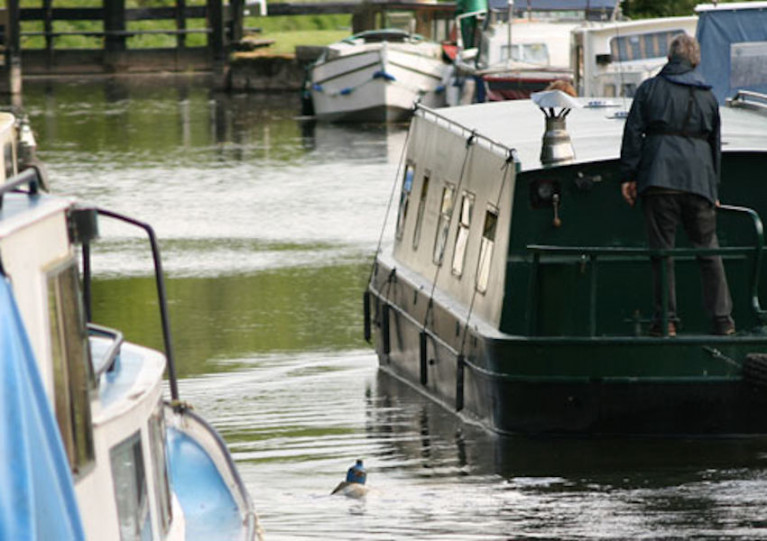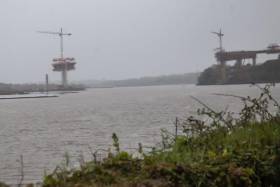Displaying items by tag: river barrow
Plans Lodged for Accessible Pontoon and Kayak Launch in Co Kilkenny
Kilkenny Live reports that Graiguenamanagh Canoe Club has lodged plans to construct an accessible floating pontoon and disabled kayak launch at The Quay on the River Barrow.
The application can be viewed on the Kilkenny County Council website and a decision is due in the new year by 24 January 2024.
Athy Community Enterprise Company Seek Boat Tour Operator for River Barrow/Grand Canal
Athy Community Enterprise Company (CLG) is seeking Expressions of Interest (EOI) from suitably qualified and experienced companies or individuals to operate its successful Athy Boat Tours
The boat tours operate on the River Barrow/Grand Canal from Athy town centre.
For information pack, please contact Brian O’Gorman email at [email protected] with ‘Athy Boat Tours’ in the subject line.
The closing date for receipt of completed applications is 12noon on Friday, 11th November 2022.
Teen Says He ‘Had No Choice’ But to Rescue Mum & Daughter From Drowning in River Barrow
A teenage boy said he “had no choice but to jump in” and rescue a mother and daughter from drowning in the River Barrow in Carlow at the weekend.
As RTÉ News reports, Miley Doran (17) told how he saw Stacey Foley jump into the water after her 13-year-old daughter Sophie Foley-Smith was caught by a sudden current.
“When I saw them drowning, I had to do the right thing,” he told RTÉ’s News at One today (Wednesday 2 June).
Ann Langton, Stacey’s mother, praised the young man from the Traveller community for his selfless actions and called for him to be honoured with a National Bravery Award.
The Irish Examiner has more on the story HERE.
Inland Barge Hire Firm Seeking Tenders for New Passenger Vessel
A Co Laois barge hire company is seeking tenders to build a new passenger vessel for use on the inland waterways.
Barrowline Cruisers in Vicarstown wants to commission and fit out a 46ft passenger barge or boat with a capacity of 36 passengers plus crew, and with a galley snack bar and toilets on board.
“The barge will ply the Grand Canal/River Barrow and the waterways of Ireland,” the company states. “It will do passenger trips and private functions. All fittings to be of a high standard.”
The firm estimates a seven-month build time for the project, which is subject to grant funding.
For more details on the tender, which is open for submissions until 5pm on Friday 9 April, see the eTenders website HERE.
Inland Fisheries Ireland (IFI) recently secured two separate convictions for illegal netting of salmon on the Barrow and Nore rivers respectively.
At a sitting of Kilkenny District Court on Tuesday 23 February 2021, Richie Lennon of New Ross, Co Wexford was fined €300 together with a €500 contribution towards costs following a prosecution taken by IFI.
Lennon pleaded guilty to the offences of illegal netting, the possession/control of four salmon and the refusal to give the name and address of another person when lawfully demanded.
The breaches of fisheries legislation occurred on 22 July 2020 on the River Barrow near Bauck in Co Carlow.
IFI fisheries officers outlined the facts of the case to the court and how Lennon had been observed in the act of illegal netting on the River Barrow, attempting to capture salmon.
Evidence in relation to the offence was given before Judge Carthy. Following the conviction, details of a previous prosecution against Lennon which had been dealt with at Wexford District Court on 15 April 2014 when the Probation Act had been applied was identified.
Judge Carthy made it clear to Lennon that if he appears in court again on similar offences, she will consider a prison sentence.
‘On the River Barrow and the River Nore, salmon stocks are well below their conservation limit and require protection’
On the same day in Kilkenny District Court, Michael Hynes of Ballybeg, Co Waterford was fined €300 together with a €500 contribution after he pleaded guilty to the offences of illegal netting, the possession of seven salmon and the refusal to give the name and address of another person when lawfully demanded.
The breaches of fisheries legislation here occurred on 22 June 2020 on the River Nore, in the townland of Clonamery, Co Kilkenny.
Evidence in relation to the offence was given before Judge Carthy sitting at Kilkenny District Court. IFI officers outlined the facts of the case to the court that Mr Hynes was apprehended and found to be in possession of seven dead salmon in his vehicle.
Lynda Connor, director of the South Eastern River Basin District at IFI, said: “I would like to commend the fisheries officers’ efforts and continuous commitment to protecting salmon.
“On the River Barrow and the River Nore, salmon stocks are well below their conservation limit and require protection. This type of illegal activity can have devastating effects on future stocks of salmon.
“These two convictions highlight the ongoing issue of illegal netting for salmon and IFI’s zero tolerance of this serious misconduct.”
Body Recovered in Search for Missing Kayaker in Athy
RTÉ News and TheJournal.ie report that a body was recovered yesterday, Saturday 6 March, in the search for a kayaker missing on the River Barrow in Athy since last weekend.
As previously reported on Afloat.ie, Declan Reid (34) and his eight-year-old son entered the water when their kayak capsized near Ardreigh Lock last Sunday afternoon (28 February).
While the boy was rescued by a passer-by, Reid disappeared — which prompted a multi-agency search operation throughout the week.
Emergency services resumed searching today (Tuesday 2 March) for a man who went missing after his kayak capsized on the River Barrow at the weekend.
According to RTÉ News, 34-year-old Declan Reid had been kayaking with his young son when the vessel overturned near Ardreigh Lock in Athy, Co Kildare on Sunday afternoon (28 February).
Independent.ie reports that Reid — who is set to be a father again in early summer — valiantly kept the eight-year-old boy afloat until he was rescued by a passer-by.
It’s also understood that Reid’s family live in the old lock-keeper’s cottage close to the scene.
Local Labour Party senator Mark Wall told TheJournal.ie: “Everyone in the town is very upset. Athy is and always has been a very close knit community … It has hit the town so hard.”
Barrow Blueway Works Get Under Way Next Month
The start date for works on the proposed Barrow Blueway has been announced by Kildare County Council in conjunction with Laois County Council and Waterways Ireland.
When complete, the scheme will provide a multi-activity 46km off-road, flat and accessible public space and leisure route along the inland waterway – together with approved paddling trails for on water access – running from Lowtown in Kildare, through the towns of Rathangan, Monasterevin, Vicarstown, to Athy.
The proposed upgrade will improve access to the beautiful Barrow Way, both on and along the water, offering an enhanced experience to walkers, cyclists, wheelchairs users, paddlers and families.
Works are to commence on Wednesday 15 July at Milltown Bridge, some 3km north of Athy, with localised closures to facilitate the upgrade of the towpath. The duration of works this year will be around 16–18 weeks.
The works will be carried out in accordance with all environmental and planning conditions and under the oversight of an ecological clerk of works, to ensure any potential negative environmental impacts are avoided and ecological mitigation is implemented in accordance with legislation and best practice.
What’s being touted as a “top tourist attraction” is due to be complete early 2022 and “will not only offer a huge economic boost, positively influencing economic growth opportunities, it will also increase that sense of community, create exciting opportunities for both recreation and ways to experience many of the community's interesting places from new perspectives”, according to the project partners.
Kildare County Council will keep the public updated as works progress on the blueway scheme, which is funded by the Government of Ireland under Project Ireland 2040.
Barrow Locals Say What River Needs Is Promotion, Not Blueway
Proposals for a new blueway along the River Barrow have been blocked by planners who objected to the scheme for a hard surface along the 115km of towpath.
But as The Irish Times reports, many locals and users of the waterway believe what the Barrow and the communities along its reach really need are better promotion.
Earlier this month, An Bord Pleanála rejected plans long in the offing for the Barrow Blueway, a new cycling and walking path between Lowtown in Co Kildare and St Mullins in Co Carlow.
Hundreds of Barrow locals had their say at public meetings, with campaigners against the path plans — among them broadcaster Olivia O’Leary — citing the existing grassy surface as more than suitable for walkers.
Others saw the blueway as “a fantastic opportunity” to save business such as pubs which have been closing at a rapid rate in rural areas, and raised the question of boggy or overgrown stretches that are a deterrent to visitors.
But others still argue that with proper maintenance and a weight of a promotional campaign behind it, the existing path would prove a major tourism attraction both domestically and abroad.
“I have people coming from the States, Canada, Australia, Europe, UK and they are just flabbergasted at how incredibly gorgeous it is, and they can’t believe there is nobody on it,” said local canoe tour operator Charlie Horan.
Those sentiments are shared by environmental journalist Lenny Antonelli, who tweeted that the Barrow is “already walkable, paddle-able and often cycle-able too.
It's already walkable, paddle-able and often cycle-able too. The #Barrow doesn't need a greenway, but it does need better marketing & promotion, particularly within Ireland, and better facilitates for visitors. Imagine if all its derelict lock cottages became bothies for example?
— lenny antonelli (@lennyantonelli) April 29, 2019
“The Barrow doesn't need a greenway, but it does need better marketing and promotion, particularly within Ireland, and better facilitates for visitors. Imagine if all its derelict lock cottages became bothies for example?”
The Irish Times has more on the story HERE.
#InlandWaterways - The scale of the New Ross bypass project for the layperson is as dizzying as its bridge over the River Barrow is going to be high.
For starters, the Killkenny People writes the scheme is 26 years in the making - from its humble beginnings in Kilkenny and Wexford County Development Plans in 1993 and 1994 for an additional river crossing around New Ross.
So to begin with, getting the project over the line took decades in terms of route selection, bridge options, an oral hearing, scheme approval, design, Compulsory Purchase Orders, tendering and all that an infrastructural development of this size entails.
Then there’s the task constructing 13.6km of dual carriageway which will boast Ireland’s longest bridge once it is completed.
For further reading on this impressive project, click here.



































































